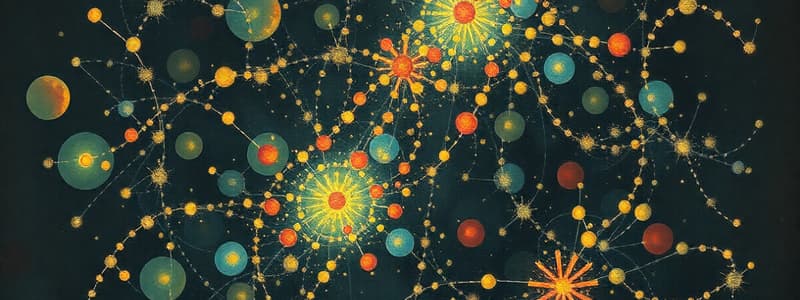Podcast
Questions and Answers
Paramagnetic elements have unpaired ______.
Paramagnetic elements have unpaired ______.
electrons
An example of a paramagnetic element is ______.
An example of a paramagnetic element is ______.
15P
Electron configuration refers to the distribution of electrons in various ______.
Electron configuration refers to the distribution of electrons in various ______.
energy levels
Ionic bonding occurs when a metal transfers an electron to a ______.
Ionic bonding occurs when a metal transfers an electron to a ______.
The compound NaCl is also known as ______ Chloride.
The compound NaCl is also known as ______ Chloride.
Alkynes are a type of hydrocarbon that contain at least one ______-carbon triple bond.
Alkynes are a type of hydrocarbon that contain at least one ______-carbon triple bond.
Diamond and graphite are ______ of carbon.
Diamond and graphite are ______ of carbon.
The maximum number of bonds a carbon atom can form is ______.
The maximum number of bonds a carbon atom can form is ______.
Atoms react to form ______ bonds to attain stability.
Atoms react to form ______ bonds to attain stability.
In covalent bonding, atoms ______ electrons with each other.
In covalent bonding, atoms ______ electrons with each other.
Helium does not combine with another He atom to form ______ because its valence shell is filled.
Helium does not combine with another He atom to form ______ because its valence shell is filled.
A sodium atom loses electrons to form a ______ ion.
A sodium atom loses electrons to form a ______ ion.
The compound MgBr₂ is classified as an ______ compound.
The compound MgBr₂ is classified as an ______ compound.
The compound AlCl₃ is known as ______ Chloride.
The compound AlCl₃ is known as ______ Chloride.
Hydrocarbons that contain a carbon-carbon triple bond are called ______.
Hydrocarbons that contain a carbon-carbon triple bond are called ______.
Diamond is used in jewelry because it is extremely ______.
Diamond is used in jewelry because it is extremely ______.
Flashcards
Paramagnetic Element
Paramagnetic Element
An element with unpaired electrons, attracted to a magnetic field.
Electron Configuration
Electron Configuration
Arrangement of electrons in energy levels and sublevels.
Ionic Bonding
Ionic Bonding
Chemical bond formed by electron transfer between a metal and nonmetal.
Covalent Bonding
Covalent Bonding
Signup and view all the flashcards
Carbon's Bonding Capacity
Carbon's Bonding Capacity
Signup and view all the flashcards
Allotropes of Carbon
Allotropes of Carbon
Signup and view all the flashcards
Hydrocarbons
Hydrocarbons
Signup and view all the flashcards
Chemical Bond
Chemical Bond
Signup and view all the flashcards
What makes an element paramagnetic?
What makes an element paramagnetic?
Signup and view all the flashcards
What is electron configuration?
What is electron configuration?
Signup and view all the flashcards
Why is Helium (He) unreactive?
Why is Helium (He) unreactive?
Signup and view all the flashcards
What are allotropes?
What are allotropes?
Signup and view all the flashcards
Carbon's Bonding Power
Carbon's Bonding Power
Signup and view all the flashcards
Study Notes
Paramagnetic Elements
- Paramagnetic elements have unpaired electrons
- They are attracted to an external magnetic field
Erwin Schrodinger
- Proposed the probability that electrons will be found in certain locations around the atom's nucleus
Electron Configuration
- Electron configuration is the distribution of electrons in various energy levels
- 3 energy level d sublevel = 3d
- Gallium (31) is in the 4th energy level and group 3
Chemical Bond
- Atoms react to form chemical bonds to become stable
- Ionic bond: Metal transfers electron to non-metal (e.g., sodium to fluorine)
- Covalent bond: Atoms share electrons (e.g., carbon to carbon)
Examples of Ionic and Covalent Compounds
- AlCl₃ (Aluminum Chloride) - Ionic
- CH₄ (Methane) - Covalent
- MgBr₂ (Magnesium Bromide) - Ionic
- NaCl (Sodium Chloride) - Ionic
Helium (He)
- Helium's valence shell is full, preventing it from bonding with another He atom
Ionic Compounds
- Metal atoms lose electrons, forming positive ions
- Non-metal atoms gain electrons, forming negative ions
- Examples of naming compounds:
- Sodium Chloride (NaCl): Salt
- Sodium Bicarbonate (NaHCO₃): Baking Soda
- Aluminum Chloride (AlCl₃)
- Magnesium Oxide (MgO)
- Calcium Fluoride (CaF₂)
Carbon and Hydrocarbons
- Carbon atoms readily form many organic compounds due to its ability to form various bonds with other carbons.
- Hydrocarbons contain carbon and hydrogen.
- Alkanes, such as Ethane, contain only single carbon-carbon bonds.
- Alkynes, such as Ethyne, contain at least one carbon-carbon triple bonds.
- Carbon forms 4 bonds
- Diamond and graphite are allotropes of carbon
- Diamond is hard and colorless
- Graphite is soft and gray
- Diamond used for cutting tools and jewelry
Studying That Suits You
Use AI to generate personalized quizzes and flashcards to suit your learning preferences.




